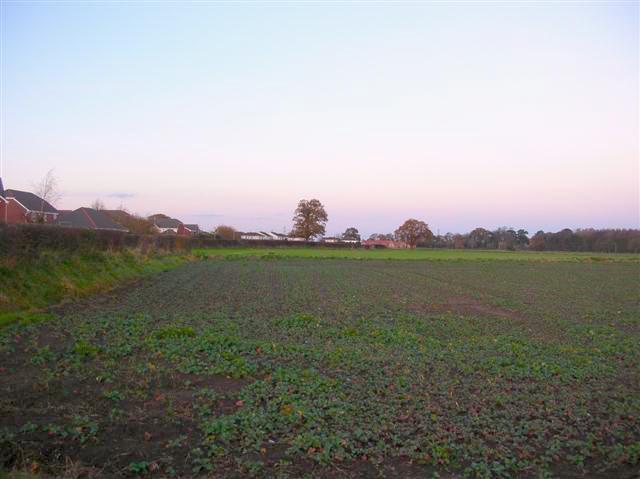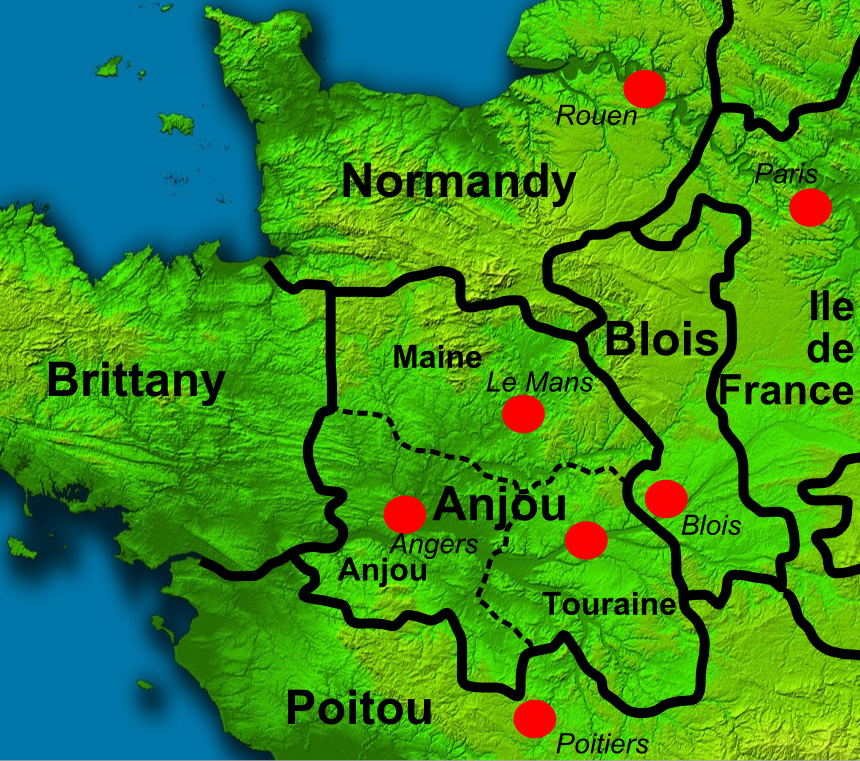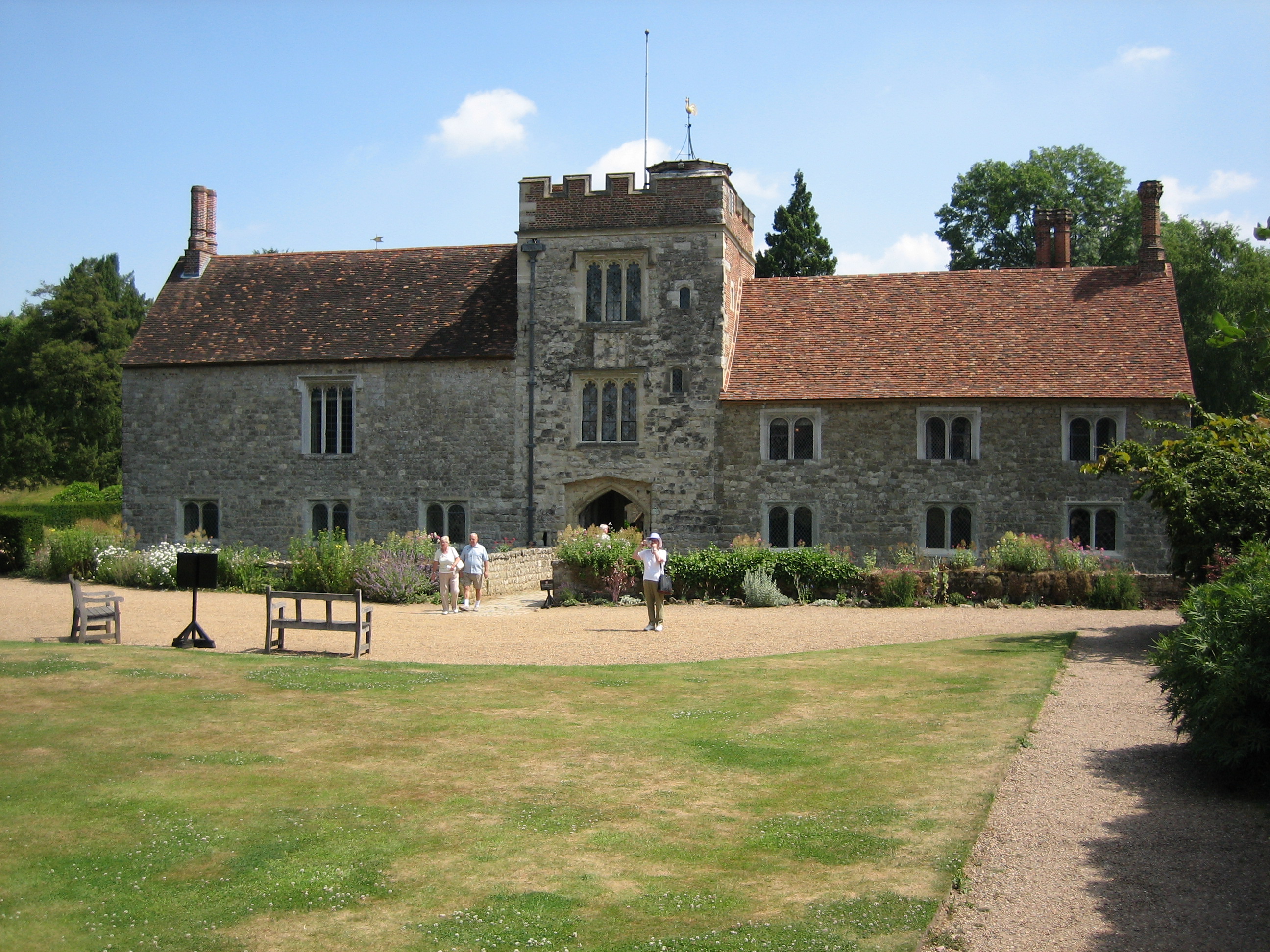|
Bampton Castle, Devon
Bampton Castle in the parish of Bampton, Devon was the seat of the feudal barony of Bampton. It is located on a spur that overlooks the River Batherm. History In Saxon times a defensive mound was built. After the Norman Conquest of England following the Battle of Hastings of 1066, the land the buildings on it, captured from Edward the Elder, were awarded to Walter Douai, who had established himself at the location by 1086. He, or perhaps his son Robert, were the ones to erect the first fortification at the site. It was a simple fortification, employing the motte and bailey style of defence. A twelve-meter motte was fortified by a timbre palisade on top. The motte was square in shape, with one side protected by the river. In 1136, during the civil war it was used against the King. King Stephen laid siege to the castle and the fortifications were burnt down. Later, a stone mansion was built on the motte, and in 1336 the lord of the manor, Richard Cogan, obtained a royal licence ... [...More Info...] [...Related Items...] OR: [Wikipedia] [Google] [Baidu] |
Bampton, Devon
Bampton is a small town and parish in northeast Devon, England, on the River Batherm, a tributary of the River Exe. It is about north of Tiverton, 19 miles (31 km) north of Exeter and the parish borders Somerset on its north-east and north-west sides. ''Bampton'' is a major part of the electoral ward of Clare and Shuttern. The ward population at the 2011 Census was 3,412. History Pre-Norman The history of Bampton is thought to have started with a Roman fort, but later Saxon remains are most easily seen. Some hedges conform to the Saxon furrow measure of 625 feet (the later furlong) and traces of Saxon strip farming can be seen to the north-east of the later castle. The circular churchyard is also Saxon in origin. Norman The 11th-century Norman Bampton Castle was built in about 1067 by Walter Douai or his son, Robert. Originally it probably had a timber tower on top of the Motte. To the east of the mound was a rectangular bailey, defended to the south by the steep sl ... [...More Info...] [...Related Items...] OR: [Wikipedia] [Google] [Baidu] |
Devon
Devon ( ; historically also known as Devonshire , ) is a ceremonial county in South West England. It is bordered by the Bristol Channel to the north, Somerset and Dorset to the east, the English Channel to the south, and Cornwall to the west. The city of Plymouth is the largest settlement, and the city of Exeter is the county town. The county has an area of and a population of 1,194,166. The largest settlements after Plymouth (264,695) are the city of Exeter (130,709) and the Seaside resort, seaside resorts of Torquay and Paignton, which have a combined population of 115,410. They all are located along the south coast, which is the most populous part of the county; Barnstaple (31,275) and Tiverton, Devon, Tiverton (22,291) are the largest towns in the north and centre respectively. For local government purposes Devon comprises a non-metropolitan county, with eight districts, and the Unitary authorities of England, unitary authority areas of Plymouth City Council, Plymouth an ... [...More Info...] [...Related Items...] OR: [Wikipedia] [Google] [Baidu] |
Feudal Barony Of Bampton
The feudal barony of Bampton was one of eight feudal baronies in Devonshire which existed during the mediaeval era, and had its ''caput'' at Bampton Castle within the manor of Bampton. Descent Domesday Book The Domesday Book of 1086 lists ''Baentone'' as one of the 27 Devon holdings of Walter of Douai, also known therein as ''Walscin''. Walter was also feudal baron of Castle Cary in Somerset. At Bampton he established a castle,Risdon, p.64 the motte of which survives today. The manor was a very large holding of 76 households, and previously to the Norman Conquest of England of 1066 had been held in demesne by King Edward the Confessor. As a manor in the royal demesne it had paid no tax. Walter had obtained it from William the Conqueror in exchange for the manors previously granted to him of Ermington and Blackawton.Thorn, part 2, 23:5 According to the Book of Fees the member manors of the barony of Bampton included: Duvale, ''Hele'' (possibly Hele, Clayhanger), Doddis ... [...More Info...] [...Related Items...] OR: [Wikipedia] [Google] [Baidu] |
Saxons
The Saxons, sometimes called the Old Saxons or Continental Saxons, were a Germanic people of early medieval "Old" Saxony () which became a Carolingian " stem duchy" in 804, in what is now northern Germany. Many of their neighbours were, like them, speakers of West Germanic dialects, including the inland Franks and Thuringians to the south, and the coastal Frisians and Angles to the north who were among the peoples who were originally referred to as "Saxons" in the context of early raiding and settlements in Roman Britain and Gaul. To their east were Obotrites and other Slavic-speaking peoples. The political history of these continental Saxons is unclear until the 8th century and the conflict between their semi-legendary hero Widukind and the Frankish emperor Charlemagne. They do not appear to have been politically united until the generations leading up to that conflict, and before then they were reportedly ruled by regional "satraps". Previous Frankish rulers of Austrasia ... [...More Info...] [...Related Items...] OR: [Wikipedia] [Google] [Baidu] |
Norman Conquest Of England
The Norman Conquest (or the Conquest) was the 11th-century invasion and occupation of England by an army made up of thousands of Normans, Norman, French people, French, Flemish people, Flemish, and Bretons, Breton troops, all led by the Duke of Normandy, later styled William the Conqueror. William's claim to the English throne derived from his familial relationship with the childless Anglo-Saxon king Edward the Confessor, who may have encouraged William's hopes for the throne. Edward died in January 1066 and was succeeded by his brother-in-law Harold Godwinson. The Norwegian king Harald Hardrada invaded northern England in September 1066 and was victorious at the Battle of Fulford on 20 September, but Godwinson's army defeated and killed Hardrada at the Battle of Stamford Bridge on 25 September. Three days later on 28 September, William's invasion force of thousands of men and hundreds of ships landed at Pevensey in Sussex in southern England. Harold marched south to oppose ... [...More Info...] [...Related Items...] OR: [Wikipedia] [Google] [Baidu] |
Battle Of Hastings
The Battle of Hastings was fought on 14 October 1066 between the Norman-French army of William, Duke of Normandy, and an English army under the Anglo-Saxon King Harold Godwinson, beginning the Norman Conquest of England. It took place approximately northwest of Hastings, close to the present-day town of Battle, East Sussex, and was a decisive Norman victory. The background to the battle was the death of the childless King Edward the Confessor in January 1066, which set up a succession struggle between several claimants to his throne. Harold was crowned king shortly after Edward's death but faced invasions by William, his own brother Tostig, and the Norwegian king Harald Hardrada (Harold III of Norway). Hardrada and Tostig defeated a hastily gathered army of Englishmen at the Battle of Fulford on 20 September 1066. They were in turn defeated by Harold at the Battle of Stamford Bridge on 25 September. The deaths of Tostig and Hardrada at Stamford Bridge left William as ... [...More Info...] [...Related Items...] OR: [Wikipedia] [Google] [Baidu] |
Stephen Of England
Stephen (1092 or 1096 – 25 October 1154), often referred to as Stephen of Blois, was King of England from 22 December 1135 to his death in 1154. He was Count of Boulogne '' jure uxoris'' from 1125 until 1147 and Duke of Normandy from 1135 until 1144. His reign was marked by the Anarchy, a civil war with his cousin and rival, the Empress Matilda, whose son, Henry II, succeeded Stephen as the first of the Angevin kings of England. Stephen was born in the County of Blois in central France as the fourth son of Stephen-Henry, Count of Blois, and Adela, daughter of William the Conqueror. His father died as a crusader while Stephen was still young, and he was brought up by his mother. Placed into the court of his uncle Henry I of England, Stephen rose in prominence and was granted extensive lands. He married Matilda of Boulogne, inheriting additional estates in Kent and Boulogne that made the couple one of the wealthiest in England. Stephen narrowly escaped drowning w ... [...More Info...] [...Related Items...] OR: [Wikipedia] [Google] [Baidu] |
Motte And Bailey
A motte-and-bailey castle is a European fortification with a wooden or stone keep situated on a raised area of ground called a motte, accompanied by a walled courtyard, or bailey, surrounded by a protective ditch and palisade. Relatively easy to build with unskilled labour, but still militarily formidable, these castles were built across northern Europe from the 10th century onwards, spreading from Normandy and Anjou in France, into the Holy Roman Empire, as well as the Low Countries it controlled, in the 11th century, when these castles were popularized in the area that became the Netherlands. The Normans introduced the design into England and Wales. Motte-and-bailey castles were adopted in Scotland, Ireland, and Denmark in the 12th and 13th centuries. By the end of the 13th century, the design was largely superseded by alternative forms of fortification, but the earthworks remain a prominent feature in many countries. Architecture Structures A motte-and-bailey castle was ... [...More Info...] [...Related Items...] OR: [Wikipedia] [Google] [Baidu] |
Lord Of The Manor
Lord of the manor is a title that, in Anglo-Saxon England and Norman England, referred to the landholder of a historical rural estate. The titles date to the English Feudalism, feudal (specifically English feudal barony, baronial) system. The lord enjoyed Manorialism, manorial rights (the rights to establish and occupy a residence, known as the manor house and demesne) as well as seignory, the right to grant or draw benefit from the estate (for example, as a landlord). The title is not a peerage or title of upper nobility (although the holder could also be a peer) but was a relationship to land and how it could be used and those living on the land (tenants) may be deployed, and the broad estate and its inhabitants administered. The title continues in modern England and Wales as a legally recognised form of property that can be held independently of its historical rights. It may belong entirely to one person or be a moiety title, moiety shared with other people. The title is know ... [...More Info...] [...Related Items...] OR: [Wikipedia] [Google] [Baidu] |
Licence To Crenellate
In medieval England, Wales and the Channel Islands a licence to crenellate (or licence to fortify) granted the holder permission to fortify his property. Such licences were granted by the king, and by the rulers of the counties palatine within their jurisdictions, i.e. by the Bishops of Durham, the Earls of Chester, and after 1351 by the Dukes of Lancaster. Licences to crenellate were issued from the 12th to 16th centuries.Goodall (2011), pp.8–9 The earliest licences present a point of contention. For instance although an authority such as John Goodall in his book ''The English Castle'' considers a charter of 1127 to be one, it was rejected as such by Philip Davis. In 1199 the administration of the country began to be systematically recorded, and the majority of licences survive in the Patent Rolls.Davis (2006–7), p.228 Letters patent were distributed and were a public declaration that the person named within had been granted permission by the king to build a fortification. ... [...More Info...] [...Related Items...] OR: [Wikipedia] [Google] [Baidu] |
Earthquake
An earthquakealso called a quake, tremor, or tembloris the shaking of the Earth's surface resulting from a sudden release of energy in the lithosphere that creates seismic waves. Earthquakes can range in intensity, from those so weak they cannot be felt, to those violent enough to propel objects and people into the air, damage critical infrastructure, and wreak destruction across entire cities. The seismic activity of an area is the frequency, type, and size of earthquakes experienced over a particular time. The seismicity at a particular location in the Earth is the average rate of seismic energy release per unit volume. In its most general sense, the word ''earthquake'' is used to describe any seismic event that generates seismic waves. Earthquakes can occur naturally or be induced by human activities, such as mining, fracking, and nuclear weapons testing. The initial point of rupture is called the hypocenter or focus, while the ground level directly above it is the ... [...More Info...] [...Related Items...] OR: [Wikipedia] [Google] [Baidu] |





